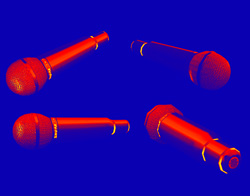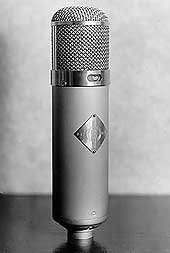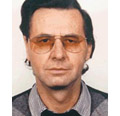
OK, so you’re thinking, “Fine, dynamic mics can’t be used to model condenser mics, but how ‘bout one of those $200 condenser mics? Surely they can be modeled into a U 87.”
Well they have a better chance, but remember there are miles of differences even among large diaphragm cardioid condensers. Distortion, frequency response, self-noise, and even that voodoo thing Neumann does with the low-end response on the U 87.
You’d have a much better chance of starting with an M149 or C12 and modeling down to an SM57, but then what would be the point?
What I’m getting at is that, as effects boxes go, modelers are great for changing the way an existing mic sounds. No doubt, they will give you more sounds to play with, if that’s what you need.
The ability to use digital signal processing to synthesize harmonic content and add it to the original signal allows us to do things we never dreamed of just several years ago.
In fact, popular music production must have new sounds or everyone gets bored and starts pushing the walls of other envelopes to relieve their boredom.
Marketing these circuits as mic modelers and positioning them as being able to replicate the performance of a condenser microphone while using a dynamic from which to model makes compelling “something for nothing” ad copy, and, in fact, you can get close within certain limitations.
I’ve EQed a dynamic mic to sound virtually indistinguishable from a large diameter condenser mic for voiceovers. In that one limited application I got really close, but with a different voice, instrument, preamp, etc. the comparison falls apart.
Don’t believe me? If mic modelers were “all that”, studios would be emptying their mic closets to make room for more mic modelers. That’s the truth winking at you.
Norbert Sobol is the product manager and chief microphone engineer at AKG in Austria. He first joined the company in 1963, and since then all major developments of professional gear from AKG went to different degrees through his hands, including the C 414EB (and all subsequently improved models since then), the AKG Tube and the C 12VR, the ULS and Blue Line Range, the C 34, C 422 and C426 stereo mics, the C 535EB – and more recently – the SolidTube, the C 4000B, C 3000B, and the C 2000B.
His long engineering history with the company makes him particularly qualified to analyze the factors involved, so I’ve asked him to address the issue. Here’s what he had to say.
“Well Ty, what you explained in these paragraphs really wraps up the subject very well. As much as I had the chance to listen in to these machines (toys?), I had a similar experience to yours.
“Just to EQ one mic to another’s frequency response is only a minor part of the story. In the real world, time-related portions of the transmitted signal plus deviations from the ideal world due to the physical size of the microphones to be simulated will effect quite considerably the polar response over the frequency range, which in turn will effect the overall sound impression when recordings are done in a real room and not an anechoic chamber.
“Then we have the effect of more or less ideal transformers used in condenser microphones together with the directly related electronic section creating a certain amount of distortion at low frequencies and interacting more or less with the microphone line and the connected equipment.”
“These are all factors. Each one on its own will probably be not noticeable, but the combination of all of them are certainly audible.”
“Now once more: It will greatly depend on the overall quality level of the recording, the recorded material, the recording room, etc. etc. if such a simulated microphone stands out like a sore thumb or will go by unnoticed or even favorably in a particular recording session.”
“So in my opinion, these machines (hardware or software-related) should be taken as an extra and sometimes interesting aspect of experimenting with sound in a creative way and the users should not take the brand names and model numbers promised to be simulated too seriously.
“At the end of the day, if one achieves a sound he/she is happy with, it does not really matter what equipment it came from. Just don’t expect too much and don’t expect consistency in the sound result, which is of course you can expect if you use a decent microphone to start off with.”
“By the way, this last statement does not stem from my association with a microphone company but reflects strictly my personal experience in this field.”


